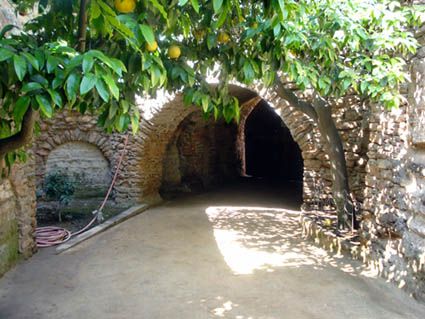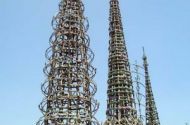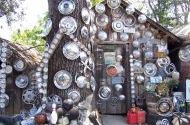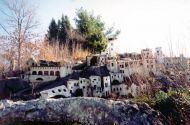The Garden of Earthly Delights in Fresno
The Garden of Earthly Delights in Fresno
(May 26, 2008)
Joseph Sciorra
Baldassare Forestiere's "Underground Gardens," Fresno, 2008.
A Brief Visit to California’s Subterranean Marvel, Baldassare Forestiere’s “Underground Gardens.”
I attended the Vernacular Architecture Forum’s conference in Fresno early this month, in part, to visit one of the great folk environments, the “Forestiere Underground Gardens.” Listed as a California Registered Historical Landmark and on the National Register of Historic Places, the privately owned site is an underground labyrinth of chambers carved from the San Joaquin Valley hardpan by Sicilian immigrant Baldassare Forestiere (1879-1946).

.jpg)
The arched passage ways, vaulted ceilings, and open skylights are part of a truly hybridic Italian/American site crafted from childhood memories of grottos and caverns from the Sicilian countryside and with the excavation skills honed digging Boston’s subway tunnels and as a “sandhog” working New York’s Holland Tunnel and Croton Aqueduct for five years after arriving in the States in 1901. Forestiere’s horticultural expertise also conjoined the training received among his father’s Sicilian olive and citrus groves in Filari (Rometta township, Messina province), and as a hired hand working as a grafter for valley farmers.


Forestiere arrived in California around 1906 and purchased seventy acres in Fresno intended for citrus only to discover the land was unsuitable for planting due to twenty-five feet of impermeable sedimentary soil. With the searing valley heat – summers could top 105 degrees – Forestiere barrowed underground to find relief. Over the course of forty years, Forestiere used only a pick, a shovel, and a wheel barrow to carve almost one hundred chambers over ten acres, digging as far down as twenty-five feet. There he grew a variety of grapevines and fruit trees – grapefruit, lemon, orange, pomegranate, quince – in oversized, handcrafted planters below opened skylights. Forestiere’s subterranean retreat is a marvel of architectural engineering and horticultural ingenuity.
Narratives, often mythical and contradictory, spring up around a number of historical folk environments like Sabato “Simon” Rodia’s Watts Towers. Vernacular architecture scholar Dell Upton notes,
Once introduced into the landscape, the identity of a building and the intentions of the makers are dissolved within confusing patterns of human perception, imagination, and use. Consequently, the meaning of a building is determined primarily by its viewers and users. This process of creation goes on long after the crew leaves the site; it never stops. Every structure contains several different buildings as imagined by different segments of its public.
It is this multivocality that often enlivens and enriches a particular site. Was it an unrequited love that spurred Forestiere to dig ever deeper as some stories claim? Was Forestiere a recluse, living “far removed from the Italian community” of Fresno, as literary scholar Kenneth Scambray writes, and embarrassment to some of his family? Baldassare’s great-niece Lorraine Forestiere, who led our tour of the troglodytic abode, is quoted as saying, “He was not a recluse. He drove a car and took flying lessons so he could commute to his orchids in Coalinga. He even invited visitors to tour his gardens on Sundays from May through September.” But was he “forced to open his caves to the public to raise funds” when his mortgagees foreclosed in 1931, according to one online post? These competing discourses perpetuate the site lingering mystery of “Why?”

Other stories are unspoken, at least in front of out-of-town guests. The unmarried Baldassare left no will when he died in 1946. According to the Los Angles Times, the property became a “contentious legacy” for two generations of Forestiere family members. The family “feud is famous in Fresno,” ending up in the California Supreme Court. Fresno city leaders are eager to resolved outstanding familial tensions so as to develop the Underground Gardens as a major city tourist attraction.
My brief sojourn to this garden of earthly delights in Frenso was a much desired and joyous treat that I eagerly anticipated for some time. Now, this modest blog post contributes, in a minor way, to the polyphony of overlapping voices that constitute the site’s shifting meanings.
Related Links
- Official Website, Forestiere Underground Gardens
- Thomas Curwen's "Dreams Dwelled Here," 01.29.04
- Wesley Roe and Marjorie Lakin Erickson's 06.25.08 post
- Judy Florman's "Labyrinth of love," 01.18.04
- Bibliography
- T. Coraghessan Boyle, Fiction, "The Underground Gardens," The New Yorker, May 25, 1998
- Valerio Ricetti, Italian-Australian hermit
DISCLAIMER: Posts published in i-Italy are intended to stimulate a debate in the Italian and Italian-American Community and sometimes deal with controversial issues. The Editors are not responsible for, nor necessarily in agreement with the views presented by individual contributors.
© ALL RIGHTS RESERVED - RIPRODUZIONE VIETATA.This work may not be reproduced, in whole or in part, without prior written permission.
Questo lavoro non può essere riprodotto, in tutto o in parte, senza permesso scritto.
Add a comment








